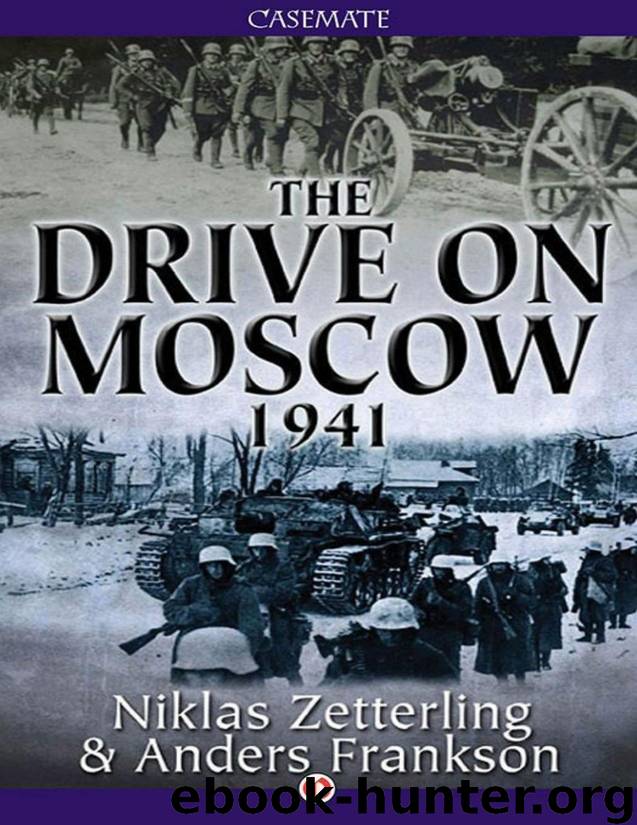The Drive on Moscow, 1941 by Niklas Zetterling & Anders Frankson

Author:Niklas Zetterling & Anders Frankson [Zetterling, Niklas & Frankson, Anders]
Language: eng
Format: epub
Published: 2017-09-09T16:00:00+00:00
TWELVE
THE END OF OCTOBERâHALFTIME FOR OPERATION TAIFUN
Guderianâs tanks had reached the outskirts of Tula, but they were only the lead elements of his panzer army. On the army groupâs left flank, the Ninth Army straightened the front line, from the arch held on October 19 to a more or less straight line from Peno to Kalinin on November 2. Konevâs Kalinin Front fell back but lost no positions of great value. It remained in the vicinity of Kalinin and halted the German efforts to capture Torzhok, as well as conducting local counterattacks. More reinforcements and weakened German defenses might allow Konev to recapture the city from which his front had received its name.1 Zhukovâs new West Front was mainly attacked by forces from Panzer Group 4 and Fourth Army.
The VolokolamskâMozhaiskâMalojaroslavetsâKaluga defense line had been broken in many places. The Germans had captured all these towns except Volokolamsk, but it too would soon fall.
The 2nd Panzer Division battle group, consisting of mechanized units such as tanks, armored personal carriers and other tracked vehicles, attacked towards Volokolamsk. The division had 16 infantry companies, but only one of them had armored halftracks, a ratio not uncommon in contemporary German panzer divisions. The 35th Infantry Division also attacked directly towards Volokolamsk. Slightly to the south, the 11th Panzer Division attacked.2 Responsibility for the defense of Volokolamsk fell on the 316th Rifle Division, commanded by Major General Panfilov of Rokossovskyâs Sixteenth Army. It was lavishly furnished with antitank guns. The crews manning these guns suffered severe losses during the battle, which turned into something akin to a defense to the last man. Militia battalions and companies from Moscow arrived during the battle and were used as replacements. 3 During the battle for Volokolamsk, General Boldin arrived with a group of soldiers after escaping the Vyazma encirclement. He had yet again broken out from a German cauldron, although his latest feat was not as epic as the previous occasion. Boldin was wounded and immediately transferred to a hospital in Moscow.
Panfilov and his division acquired hero status from their conduct during the battle of Volokolamsk, even though they were unable to hold the Germans back. The Volokolamsk rail station was located south of the town and it was captured by tanks from the 2nd Panzer Division on October 25. Two days later, the 35th Infantry Division captured Volokolamsk. Istra was also threatened from the south by the 10th Panzer Division, but it would hold out another month. Panzer Group 4 discontinued its attacks, as it needed 1,000â1,500 tons of supply each day. As only 200 tons were arriving daily, this was utterly insufficient to maintain the offensive. 4 Zhukov had to create new defenses along the line KlinâIstraâDorochovoâVorovskâ Serpuchov, but the German Fourth Army had already broken through at Dorochovo and Vorovsk in October. Von Kluge and his army had already reached the next Soviet defense line, Naroâ Fominsk. However, poor weather, lack of supplies and stiffening opposition compelled von Kluge to cancel further attacks.
During the second
Download
This site does not store any files on its server. We only index and link to content provided by other sites. Please contact the content providers to delete copyright contents if any and email us, we'll remove relevant links or contents immediately.
| Africa | Americas |
| Arctic & Antarctica | Asia |
| Australia & Oceania | Europe |
| Middle East | Russia |
| United States | World |
| Ancient Civilizations | Military |
| Historical Study & Educational Resources |
Flight by Elephant(1481)
The Rise and Fall of the Third Reich: A History of Nazi Germany by William L. Shirer(1382)
Unbroken: A World War II Story of Survival, Resilience, and Redemption by Hillenbrand Laura(1099)
German submarine U-1105 'Black Panther' by Aaron Stephan Hamilton(1018)
Last Hope Island by Lynne Olson(933)
A Bridge Too Far by Cornelius Ryan(928)
War by Unknown(904)
The Victors - Eisenhower and His Boys The Men of World War II by Stephen E. Ambrose(901)
The Guns at Last Light: The War in Western Europe, 1944-1945 by Rick Atkinson(887)
Rogue Heroes: The History of the SAS, Britain's Secret Special Forces Unit That Sabotaged the Nazis and Changed the Nature of War by Ben Macintyre(883)
0060740124.(F4) by Robert W. Walker(871)
The Hitler Options: Alternate Decisions of World War II by Kenneth Macksey(865)
The Railway Man by Eric Lomax(846)
All the Gallant Men by Donald Stratton(814)
Hitler's Vikings by Jonathan Trigg(808)
A Tragedy of Democracy by Greg Robinson(800)
Churchill's Secret War by Madhusree Mukerjee(796)
Hitler's Armies by Chris McNab(781)
We Die Alone: A WWII Epic of Escape and Endurance by David Howarth & Stephen E. Ambrose(745)
